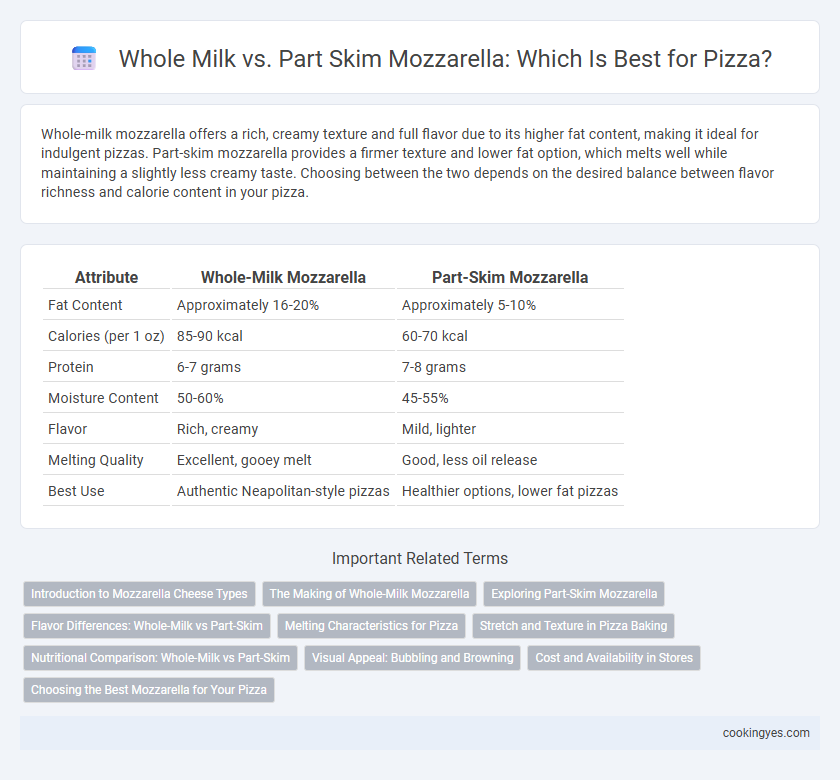Whole-milk mozzarella offers a rich, creamy texture and full flavor due to its higher fat content, making it ideal for indulgent pizzas. Part-skim mozzarella provides a firmer texture and lower fat option, which melts well while maintaining a slightly less creamy taste. Choosing between the two depends on the desired balance between flavor richness and calorie content in your pizza.
Table of Comparison
| Attribute | Whole-Milk Mozzarella | Part-Skim Mozzarella |
|---|---|---|
| Fat Content | Approximately 16-20% | Approximately 5-10% |
| Calories (per 1 oz) | 85-90 kcal | 60-70 kcal |
| Protein | 6-7 grams | 7-8 grams |
| Moisture Content | 50-60% | 45-55% |
| Flavor | Rich, creamy | Mild, lighter |
| Melting Quality | Excellent, gooey melt | Good, less oil release |
| Best Use | Authentic Neapolitan-style pizzas | Healthier options, lower fat pizzas |
Introduction to Mozzarella Cheese Types
Mozzarella cheese is available primarily in whole-milk and part-skim varieties, each offering distinct texture and flavor profiles crucial for pizza quality. Whole-milk mozzarella contains higher fat content, providing a creamy texture and richer taste, while part-skim mozzarella offers a firmer texture with lower fat, making it a popular choice for those seeking a balance between meltability and reduced calories. Selecting the appropriate mozzarella type affects the pizza's moisture, stretchability, and overall flavor richness.
The Making of Whole-Milk Mozzarella
Whole-milk mozzarella is crafted from fresh, untreated cow's milk, resulting in a rich, creamy texture and enhanced flavor due to its higher fat content compared to part-skim varieties. The process involves stretching the curds in hot whey or water, which gives the cheese its characteristic elasticity while preserving the moisture and fat that contribute to superior melt quality. This method yields mozzarella that melts evenly and produces a gooey texture ideal for traditional, authentic pizza recipes.
Exploring Part-Skim Mozzarella
Part-skim mozzarella offers a balanced fat content, making it a popular choice for pizzas that require a meltable texture with less greasiness compared to whole-milk mozzarella. It contains approximately 45-50% moisture and lower fat levels, which helps achieve a stretchy consistency while reducing overall calorie intake. This type of mozzarella also browns evenly without releasing excessive oils, enhancing both the flavor and appearance of pizza toppings.
Flavor Differences: Whole-Milk vs Part-Skim
Whole-milk mozzarella boasts a richer, creamier flavor due to its higher fat content, which enhances the overall taste experience on pizza. Part-skim mozzarella offers a milder, less buttery flavor with a firmer texture, making it a popular choice for those seeking a lighter option without sacrificing meltability. The difference in fat levels directly impacts the flavor intensity and mouthfeel, influencing the pizza's taste profile.
Melting Characteristics for Pizza
Whole-milk mozzarella offers superior melting characteristics for pizza, producing a creamier texture and a richer flavor due to its higher fat content. Part-skim mozzarella melts with less oil separation, yielding a firmer texture and a slightly less gooey consistency that some pizza styles prefer. Choosing between whole-milk and part-skim mozzarella depends on the desired melt quality and texture for specific pizza recipes.
Stretch and Texture in Pizza Baking
Whole-milk mozzarella offers a creamier texture and superior meltiness, creating rich, gooey stretch ideal for classic pizza styles. Part-skim mozzarella has a firmer texture and less moisture, resulting in a stretchier but less creamy melt that holds shape better during baking. Choosing whole-milk enhances softness and richness, while part-skim optimizes structural integrity and browning in high-temperature ovens.
Nutritional Comparison: Whole-Milk vs Part-Skim
Whole-milk mozzarella contains higher fat content, typically around 20-25%, providing a creamier texture and richer flavor, while part-skim mozzarella has about 10-15% fat, offering a lower-calorie option with reduced saturated fat. Both varieties deliver similar protein levels, approximately 6-7 grams per ounce, but part-skim mozzarella has lower total calories, roughly 70-80 compared to whole-milk's 85-90 per ounce. Choosing between whole-milk and part-skim mozzarella depends on nutritional goals, balancing taste preferences with fat and calorie intake.
Visual Appeal: Bubbling and Browning
Whole-milk mozzarella produces a richer, creamier melt with golden browning and more pronounced bubbling, enhancing a pizza's visual appeal. Part-skim mozzarella offers a firmer melt with less bubbling and lighter browning, resulting in a cleaner, less oily appearance. Choosing whole-milk cheese elevates the pizza's aesthetic by creating vibrant, bubbly textures and appetizing golden spots.
Cost and Availability in Stores
Whole-milk mozzarella tends to be more expensive than part-skim due to its higher fat content and richer texture, which requires more milk in production. Part-skim mozzarella is more widely available in stores, especially in supermarkets, as it appeals to consumers seeking a lower-fat, cost-effective option. Both types are commonly stocked, but part-skim often dominates in price-sensitive markets because of its affordability and longer shelf life.
Choosing the Best Mozzarella for Your Pizza
Whole-milk mozzarella offers a richer, creamier texture and melts more evenly, making it ideal for gourmet or Neapolitan-style pizzas that emphasize flavor and softness. Part-skim mozzarella has lower moisture and fat content, providing a firmer consistency and less oiliness, which suits pizzas that require a more resilient cheese structure, such as New York-style slices. Selecting between whole-milk and part-skim mozzarella depends on the desired melt quality, flavor intensity, and overall pizza style.
Whole-milk vs Part-skim for mozzarella Infographic

 cookingyes.com
cookingyes.com